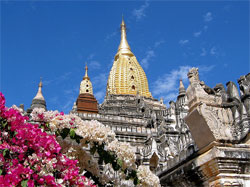Ananda Temple is one of the four main temples remaining in Bagan. Ananda temple is considered to be one of the most surviving masterpiece of the Mon architecture. Also known as the finest, largest, best preserved and most revered of the Bagan temples. During the 1975 earthquake, Ananda suffered considerable damage but has been totally restored.
History
It is said to have been built around 1105 by King Kyanzittha, this perfectly proportioned temple heralds the stylistic end of the Early Bagan period and the beginning of the Middle period. In 1990, on the 900th anniversary of the temple's construction, the temple spires were gilded. The remainder of the temple exterior is whitewashed from time to time.

There is a legend saying that there were 8 monks who arrived one day to the palace begging for alms. They told the king that once, they had lived in the Nandamula Cave temple in the Himalayas. The King was fascinated by the tales and invited the monks to return to his palace. The monks with their meditative powers they showed the king the mythical landscape of the place they have been. King Kyanzittha was overwhelmed by the sight and had a desire for building a temple which would be cool inside in the middle of the Bagan plains. After the construction of the temple, the king executed the architects just to make the style of the temple so unique.
The structure of Ananda temple is that of a simple corridor temple. The central square measures 53 metres along each side while the superstructure rises in terraces to a decorative cliff 51 metres above the ground. The entrance ways make the structure into a perfect cross, each entrance is crowned with a stupa finial. The base and the terraces are decorated with 554 glazed tiles showing jataka scenes (life stories of the Buddha) thought to be derived from Mon texts. Huge carved teak doors separate interior halls from cross passages on all four sides.
Facing outward from the centre of the cube, four 9.5-metre standing Buddhas represent the four Buddhas who have attained nibbana (nirvana). Only the Bagan-style images facing north and south are original; both display the dhammachakka mudra, a hand position symbolising the Buddha's first sermon. The other two images are replacements for figures destroyed by fires. All four have bodies of solid teak, though guides may claim the southern image is made of a bronze alloy. If one stand by the donation box in front of the original southern Buddha his face looks sad; while from a distance he tends to look mirthful. The architecture of the images were so artistic that they happen to make such appearance.
The Buddha Images at four sides are Kassapa at the South, Kakusanda at the North, Konagamana at the east and Gotama at the West.
The eastern and western standing Buddha images are done in the later Konbaung or Mandalay style. A small nutlike sphere held between thumb and middle finger of the east-facing image is said to resemble a herbal pill and may represent the Buddha offering dhamma (Buddhist philosophy) as a cure for suffering. Both arms hang at the image's sides with hands outstretched, a mudra unknown to traditional Buddhist sculpture outside this temple. The west-facing Buddha features the abhaya mudra with the hands outstretched in the gesture of 'no fear'.
At the feet of the standing Buddha, in the western sanctum, sit two life-size lacquer statues said to represent King Kyanzittha and Shin Arahan, the Mon monk who initiated the king into Theravada Buddhism. Inside the western portico are two Buddha footprint symbols on pedestals.
Ananda temple festival falls on the full moon of Pyatho (usually between December and January, according to the Lunar Calendar). The festival attracts thousands of locals from near and far. Up to a thousand monks chant day and night during the three days of the festival.
Travel Tips
The best time to visit Bagan is just after the raining season when all the monuments and pagodas are washed by the rain and the environment is green. It is about October.
If you want to learn about the local people and their traditions, you should go during the festival time, which is usually in February, but depends on the solar calendar.
The best way to travel around the pagodas is with a horse cart driven by locals.



